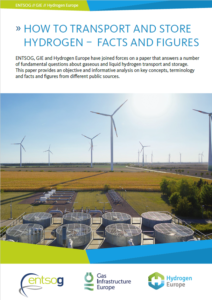
The EU has set a goal of achieving climate neutrality by 2050 and decided to raise its 2030 climate target to 55%. For this, the EU needs to transform its energy system. It is of paramount importance that it will become more efficient, affordable and interconnected. Hydrogen can play a pivotal role in the EU’s decarbonisation efforts and be at the centre of the energy system integration, supporting transport of renewable energy over very long distances and facilitating renewables storage from one season to another.
ENTSOG, GIE and Hydrogen Europe have joined forces on a factsheet that answers a number of fundamental questions about gaseous and liquid hydrogen transport and storage, titled “How to transport and store hydrogen? Facts and figures”. This factsheet provides an objective and informative analysis on key concepts, terminology and facts and figures from different public sources.
The factsheet illustrates the EU’s potential to enable a global hydrogen economy and to become a global technology leader, due to its extensive gas infrastructure that can be used to transport blends of hydrogen or be converted to transport pure hydrogen.
Downloads

Gas Infrastructure Europe (GIE) is the association representing the interests of European gas infrastructure operators. GIE members are active in transmission, storage and regasification via LNG terminals of renewable and low-carbon gases, including natural gas and hydrogen. Gathering around 70 industry entities from 27 European countries, GIE perfectly embodies the multiple transitional decarbonisation pathways of the EU regions. The association’s vision is that by 2050, the gas infrastructure will be the backbone of the new innovative energy system, allowing European citizens and industries to benefit from a secure, efficient and sustainable energy supply. For more information, visit www.gie.eu or contact gie@gie.eu.
![]()
The European Network of Transmission System Operators for Gas (ENTSOG) was founded in line with Regulation (EC) 715/2009 and has played a key role in facilitating integration of the European gas markets, ensuring technical interoperability and providing security of supply by gas infrastructure planning. Looking forward, ENTSOG is contributing to the net-zero decarbonisation by 2050, in particular, by the integration of renewable and low carbon gases via future-proof gas transmission pipelines, in line with the EU energy and climate goals. More information on ENTSOG can be found on our website – www.entsog.eu or contact info@entsog.eu.
![]()
Hydrogen Europe is the European association representing the interest of the hydrogen and fuel cell industry and its stakeholders. It promotes hydrogen as an enabler of a zero-emission society. With more than 260 companies and 27 national associations as members, our association encompasses the entire value chain of the European hydrogen and fuel cell ecosystem collaborating with the European Commission in the Fuel Cell Hydrogen Joint Undertaking. For further information, please visit www.hydrogeneurope.eu or contact secretariat@hydrogeneurope.eu.













































